Elias Dumaresq, 5th Seigneur of Augres was born in 1674 and was a Seigneur of Augres located in the parish of Trinity, Jersey, the largest of the Channel Islands, He belonged to the influential Dumaresq family. [1]
Elias Dumaresq, 5th Seigneur of Augres was born in 1674 and was a Seigneur of Augres located in the parish of Trinity, Jersey, the largest of the Channel Islands, He belonged to the influential Dumaresq family. [1]
Elias Dumaresq was the son of, Elias Dumaresq, 4th Seigneur of Augres (1648–1734) and Frances De Carteret, daughter of Sir Francis de Carteret, Attorney-General of Jersey (1619–1693) and Anne Seale (1641–1703) and thus the grandchild of Sir Philippe de Carteret II, Bailiff and Lieut-Governor of Jersey through his maternal grandfather. [2] [3]

Elias Dumaresq and his wife Elizabeth de Carteret resided at the Les Augrès Manor, what had been in the Dumaresq family since the mid-16th century. Elias continued to live at the manor even though it with in the Fief de Diélament not the Fief des Augrès. As Elias was the Seigneur of the Fief des Augrès, the manor became known as Les Augrès Manor. [4]
The Manor is depicted on the 2010 issue Jersey 5 pound note and now forms the headquarters of the Durrell Wildlife Conservation Trust (formerly Jersey Wildlife Preservation Trust) [5]
Elie Dumaresq's estate became the subject of bankruptcy procedures in 1734.
Elias married Elizabeth de Carteret (died 1765), daughter of Sir Amice De Carteret (1635–1703), and his wife Sarah Dumaresq (1643–1707) They had issue: [6]
| Ancestors of Elias Dumaresq, 5th Seigneur of Augres | ||||||||||||||||||||||||||||||||||||||||||||||||||||||||||||||||||||||||||||||||||||||||||||||||||||||||||||||||||||||||||||||||||||||||||||||||||||||||||||||||||||||||||||||||||||||||||||||||||||||||||||||||||||||||||||||||||||||||||||||||||||||||||||||||||||||||||||||||||||||||||||||||||||||||||||||||||||||||||||||||||||||||||||||||||||||||||||||||||||||||||||||||||||||||||||||||||||||||||||||||||||||||||||||||||||||||||||||||||||||||||||||||||||||||||||||||||||||||||||||||||||||||||||||||||||||||||||||||||||||||||||||||||||||||||||||||||||||||||||||||||||||||||||||||||||||||||||||||
|---|---|---|---|---|---|---|---|---|---|---|---|---|---|---|---|---|---|---|---|---|---|---|---|---|---|---|---|---|---|---|---|---|---|---|---|---|---|---|---|---|---|---|---|---|---|---|---|---|---|---|---|---|---|---|---|---|---|---|---|---|---|---|---|---|---|---|---|---|---|---|---|---|---|---|---|---|---|---|---|---|---|---|---|---|---|---|---|---|---|---|---|---|---|---|---|---|---|---|---|---|---|---|---|---|---|---|---|---|---|---|---|---|---|---|---|---|---|---|---|---|---|---|---|---|---|---|---|---|---|---|---|---|---|---|---|---|---|---|---|---|---|---|---|---|---|---|---|---|---|---|---|---|---|---|---|---|---|---|---|---|---|---|---|---|---|---|---|---|---|---|---|---|---|---|---|---|---|---|---|---|---|---|---|---|---|---|---|---|---|---|---|---|---|---|---|---|---|---|---|---|---|---|---|---|---|---|---|---|---|---|---|---|---|---|---|---|---|---|---|---|---|---|---|---|---|---|---|---|---|---|---|---|---|---|---|---|---|---|---|---|---|---|---|---|---|---|---|---|---|---|---|---|---|---|---|---|---|---|---|---|---|---|---|---|---|---|---|---|---|---|---|---|---|---|---|---|---|---|---|---|---|---|---|---|---|---|---|---|---|---|---|---|---|---|---|---|---|---|---|---|---|---|---|---|---|---|---|---|---|---|---|---|---|---|---|---|---|---|---|---|---|---|---|---|---|---|---|---|---|---|---|---|---|---|---|---|---|---|---|---|---|---|---|---|---|---|---|---|---|---|---|---|---|---|---|---|---|---|---|---|---|---|---|---|---|---|---|---|---|---|---|---|---|---|---|---|---|---|---|---|---|---|---|---|---|---|---|---|---|---|---|---|---|---|---|---|---|---|---|---|---|---|---|---|---|---|---|---|---|---|---|---|---|---|---|---|---|---|---|---|---|---|---|---|---|---|---|---|---|---|---|---|---|---|---|---|---|---|---|---|---|---|---|---|---|---|---|---|---|---|---|---|---|---|---|---|---|---|---|---|---|---|---|---|---|---|---|---|---|---|---|---|---|---|---|---|---|---|---|---|---|---|---|---|---|---|---|---|---|---|---|---|---|---|---|---|---|---|---|---|---|---|---|---|---|---|---|---|---|---|---|---|---|---|---|---|---|---|---|---|---|---|---|---|---|---|---|---|---|---|---|---|---|---|---|---|---|---|---|---|---|---|---|---|---|---|---|---|---|---|---|---|---|---|---|---|---|---|---|---|---|---|---|---|---|---|---|---|---|---|---|---|---|---|---|---|---|---|---|---|---|---|---|---|---|---|---|---|---|---|---|---|
| ||||||||||||||||||||||||||||||||||||||||||||||||||||||||||||||||||||||||||||||||||||||||||||||||||||||||||||||||||||||||||||||||||||||||||||||||||||||||||||||||||||||||||||||||||||||||||||||||||||||||||||||||||||||||||||||||||||||||||||||||||||||||||||||||||||||||||||||||||||||||||||||||||||||||||||||||||||||||||||||||||||||||||||||||||||||||||||||||||||||||||||||||||||||||||||||||||||||||||||||||||||||||||||||||||||||||||||||||||||||||||||||||||||||||||||||||||||||||||||||||||||||||||||||||||||||||||||||||||||||||||||||||||||||||||||||||||||||||||||||||||||||||||||||||||||||||||||||||

The Seigneur of Sark is the head of Sark in the Channel Islands. "Seigneur" is the French word for "lord", and a female head of Sark is called Dame of Sark, of which there have been three. The husband of a female ruler of Sark is not a consort but is jure uxoris a seigneur himself.

Sir Philip Carteret, 2nd Baronet, also known as Philippe de Carteret IV, was the 5th Seigneur of Sark from 1663 to 1693.
Sir Philip Carteret, 1st Baronet, also known as Philippe de Carteret III, was the 4th Seigneur of Sark. He supported the Royalist (Cavalier) cause during the War of the Three Kingdoms.
Philippe de Carteret II, 3rd Seigneur of Sark was the son of Philippe de Carteret I (1552–1594) and Rachel Paulett (1564–1650), daughter of George Paulett (1534–1621) who was Bailiff of Jersey from 1583 to 1611, and his wife Elizabeth Perrin (1538–1615).
Philippe de Carteret I, 2nd Seigneur of Sark (1552–1594) was the Seigneur of Sark and Saint Ouen from 1578 to 1594.
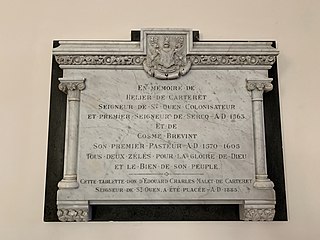
Hellier de Carteret was the first Seigneur of Sark, reigning from 1563 to 1578. He was the son of Édouard de Carteret, Seigneur of Saint Ouen, and grandson of Philip de Carteret, 8th Seigneur of St Ouen.
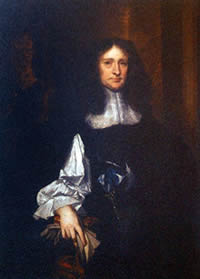
Vice-Admiral Sir George Carteret, 1st Baronet was a royalist statesman in Jersey and England, who served in the Clarendon Ministry as Treasurer of the Navy. He was also one of the original lords proprietor of the former British colony of Carolina and New Jersey. Carteret, New Jersey, as well as Carteret County, North Carolina, both in the United States, are named after him. He acquired the manor of Haynes, Bedfordshire, in about 1667.
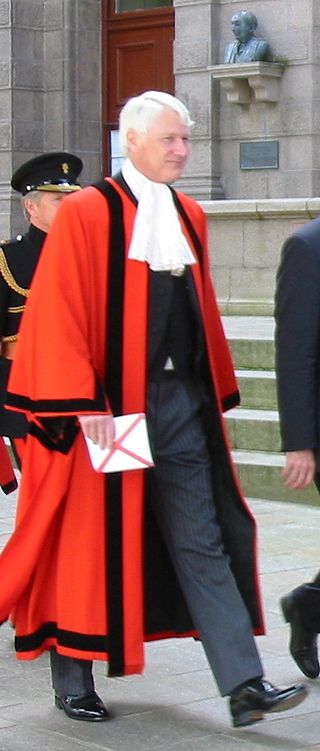
The Bailiff of Jersey is the civic head of the Bailiwick of Jersey. In this role, he is not the head of government nor the head of state, but the chief justice of Jersey and presiding officer of Jersey's parliament, the States Assembly. The Bailiff is also the President of the Royal Court. It is similar in role to the Bailiff of Guernsey.

Trinity is one of the twelve parishes of Jersey in the Channel Islands. It is 5.8 kilometres (3.6 mi) north of St Helier. It has a population of 3,156. The parish covers 6,975 vergées (12.3 km2 [4.7 sq mi]). Les Platons in the north of the parish is the highest point in Jersey. The parish borders St John, St Helier, St Saviour and St Martin.
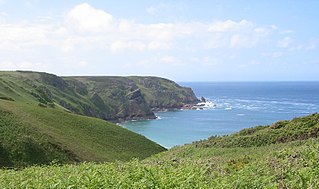
St Ouen is one of the twelve parishes of Jersey in the Channel Islands. It is around 8.8 kilometres (5.5 mi) north-west of St Helier. It has a population of 4,097. The parish is the largest parish by surface area, covering 8,525 vergées (15 km2), and is located in part on a peninsula.

Les Augrès Manor is a manor house on La Profonde Rue in the Vingtaine de Rozel in the parish of Trinity in Jersey. The present building mostly dates from the 19th century, although the site has medieval origins. It is a listed building.
The Seigneur of Saint Ouen is a manorial title in Jersey. Their traditional seat is Saint Ouen's Manor. The first was Renaud De Carteret I.

The de Carteret family was perhaps the greatest of the patrician families of the Channel Islands. Their influence on the Island would last from the 10th century until the present time.
Carteret is a surname of Norman origin. It derives from Carteret, Normandy, an inhabited place on the northwest coast of the Cotentin peninsula, facing the Channel Islands. The Channel Islands are the only remnant of the Duchy of Normandy, the original territorial holding of William the Conqueror, who invaded England in 1066. Historically, members of the Carteret family have occupied influential positions in the Channel Islands, notably as hereditary Seigneurs of Sark and hereditary Bailiffs of Jersey.

George Paulett (1534-1621) was Bailiff of Jersey multiple times during a period from 1583 to 1611 and was temporary Lieutenant-Governor of Guernsey.
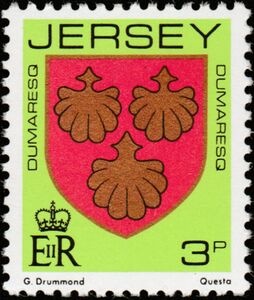
The Dumaresq family was a patrician family in the Channel Islands with a particularly strong presence in Jersey. The family would hold many offices and positions throughout the history of Jersey from the 13th century.

The Seigneur of Augrès is a noble title in Jersey, which still follows the Norman system. They traditionally lived in Les Augrès Manor, which was actually in the fief of Diélament and not Augrès.

Elias Dumaresq, 3rd Seigneur of Augrès was born to Abraham Dumaresq, 2nd Seigneur of Augrès and Susan de Carteret daughter of Philippe de Carteret I, 2nd Seigneur of Sark and his wife Racheal Paulet. He was a Royalist and a Jurat of the Royal Court.
Abraham Dumaresq, 2nd Seigneur of Augres (1571-1631), held the manorial fief of Les Augrès, in the Island of Jersey and would be the first of the Des Augres branch of the Dumaresq Family.